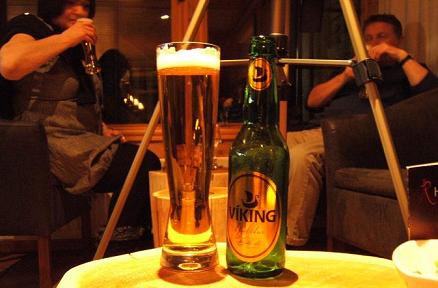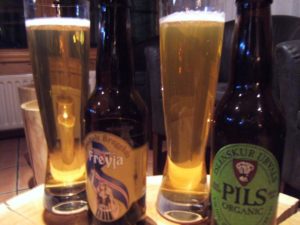
She: (In Icelandic) …he appears to be taking a photo of that beer…
He: (In Icelandic) I wish I had the daring to do such things.
Discounting Yorkshire, Iceland is the first Scandinavian country that I’d ever visited. I’m a chilly mortal. Why would I choose to holiday in the frozen north in February rather than jetting off to some tropical paradise? Easy answer. Two words. Northern Lights. Nature’s fireworks. ‘nough said! But it’s not all so obviously attractive. If you holiday outside the UK quaffing invariably means lager. I always find it laughable that you visit a hot country and, in the main, the ‘indigenous’ beer is all too often a bland Euro-fizz style lager chilled to buggery. But Iceland is a cold country and lager is a cold country beer so lager felt like the right and proper thing to be drinking.
 To the uninitiated (me) buying beer from a supermarket in Iceland can be a big disappointment. The beer looks like the genuine article with the usual sort of names you might expect to see in Iceland. I didn’t realise, until I got back to the hotel room, that the can of Gull and the can of Viking that I had purchased were only 2.25% in strength. Have you ever tried weak cabbage soup? It’s not pleasant but much more flavoursome than these two, well I hesitate to call them, beers. I managed a can and a half. Anymore and I think I would have lost the will to live. Apparently beer above 2.25% can only be sold in government owned off licences bars and hotels etc. I hadn’t seen the word ‘Light’, ironically printed lightly on the can. Let that be a warning to you!
To the uninitiated (me) buying beer from a supermarket in Iceland can be a big disappointment. The beer looks like the genuine article with the usual sort of names you might expect to see in Iceland. I didn’t realise, until I got back to the hotel room, that the can of Gull and the can of Viking that I had purchased were only 2.25% in strength. Have you ever tried weak cabbage soup? It’s not pleasant but much more flavoursome than these two, well I hesitate to call them, beers. I managed a can and a half. Anymore and I think I would have lost the will to live. Apparently beer above 2.25% can only be sold in government owned off licences bars and hotels etc. I hadn’t seen the word ‘Light’, ironically printed lightly on the can. Let that be a warning to you!
On the night we arrived we’d tried a couple of beers, Viking and Þorra Bjor. We liked what we tasted. Pilsner beers of quality. I will return to these later. Iceland has a near zero tolerance on driving with alcohol in your system so I certainly didn’t drink in the day. A couple of evenings I stuck to vodka, which seemed appropriate for the environment. But we planned to have a sampling session on the last evening. This consisted of us going to the bar and working our way through as many beers as we dared. First up was Hrammur beer from Viking (Vifilfell Hf) 4.6% a light creamy lager that could just about be anything. Bland best describes it but the hint of flavour made it more acceptable than much of the mass-produced fizz we get in the UK.
 One beer in and our session was interrupted, “the lights are showing” went up the cry. Drinks in the bar were abandoned; meals in the restaurant were treated with equal nonchalance. We got our coats. This time it was for real. On the last night of our holiday the gods had finally relented and given us the most fantastic experience. I lost count of the amount of times I heard the word ‘wow’, including from myself. If you’ve not seen the Northern Lights then it is very hard to explain how they make you feel. They appeared as white cloud like objects that twisted and undulated changing to a glowing green and then back to white. Afterwards I heard someone describe them as awesome. For once this word was used correctly.
One beer in and our session was interrupted, “the lights are showing” went up the cry. Drinks in the bar were abandoned; meals in the restaurant were treated with equal nonchalance. We got our coats. This time it was for real. On the last night of our holiday the gods had finally relented and given us the most fantastic experience. I lost count of the amount of times I heard the word ‘wow’, including from myself. If you’ve not seen the Northern Lights then it is very hard to explain how they make you feel. They appeared as white cloud like objects that twisted and undulated changing to a glowing green and then back to white. Afterwards I heard someone describe them as awesome. For once this word was used correctly.
Nature’s fireworks over we returned to the bar to carry on with our beer quest. The next choice was Skjalfti a 5% beer from Brugghus; slightly darker than your typical lager this beer has mouthfuls malt along with a very pleasing beech nut flavour. This is a beer that has been brewed with love. Nestling under the surface is the Smell and taste of oak casks. It’s a beer that reminds one slightly of Innis & Gunn. So, nothing wrong with that then. Whilst I was enjoying Skjalfti ‘the lady’ was trying a wheat beer (one of her loves). Freyja 4.5% also from Brugghus is a wheat beer with pronounced floral notes, elderflower I think, with a vague cream of soda buzz and lemon pith (as opposed to the sharpness of lemon peel). This was not in the gutsy style of German wheat beers but seemed to lean to the Dutch/Belgium wit beer approach. Thankfully it had much more flavour than your typical Flemish blank Blanc.
Onward and upward we went organic with Islenskur Urvals Pils Organic 5%, another brewed by Vifilfell Hf. A pungent aroma of hops invades the nasal passages as you place the glass to your lips enhancing the drinking experience quite dramatically. This well rounded pilsner beer is fruity with a minimal bitterness. This is one class act pilsner. Þorra Bjor 5.1% the Þ is pronounced ‘th’ as in theosophy is a seasonal beer brewed for a recently resurrected winter festival. Its brewed to accompany what Icelanders we encountered referred to as ‘bad food’ By all accounts ‘bad food’ consists of fermented shark meat and sheep’s testicles plus other assorted left-overs. The bad food didn’t appeal to us but this malty, slightly bitter beer was a sure fire winner. Not dissimilar to a barley wine this was a worryingly quaffable beer. It’s probably just as well that the bar ran out of it before anymore could be ordered. Vifilfell also brewed this fine beer. The last offering, again from Vifilfell was the 5.6% Viking their flagship brew. And, yes it is pretty ‘flagship’! Vifilfell do seem to have perfected the act of brewing quality pilsner beer. It is a robust beer with a fabulous balance of hop on the nose and the palate followed up by a malt-rich mouth soothing finish. All in all our sampling was a good session.
I’d have liked to have drunk a lot more Icelandic beer but at around £5 – £6 for a 330 ml glass it is an expensive pastime. On the upside it makes you savour and enjoy the beer even more when you know you can’t really afford to neck it. Our visit to Iceland is the best holiday that we’ve ever had and we’d love to go back. The beer is great but the natural sights make the beer pale into insignificance. We were also impressed with Icelandair who we note also fly to Canada. We could be tempted. Do you need a piece on Canadian beer Alan?
Yesterday watching Twitter election 2011 flow by was one of the most bizarre things I have ever witnessed in politics.





